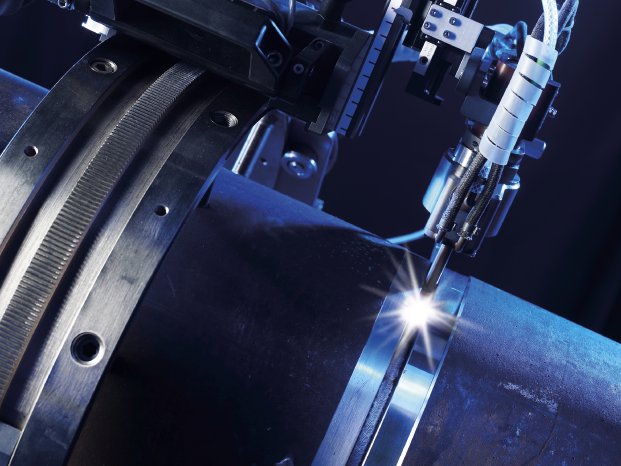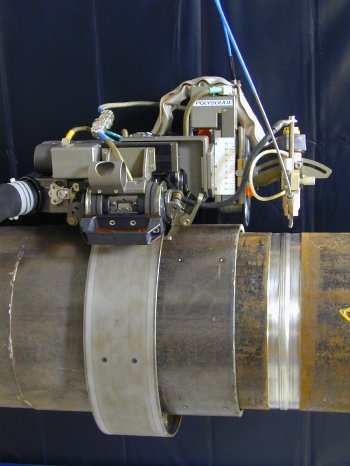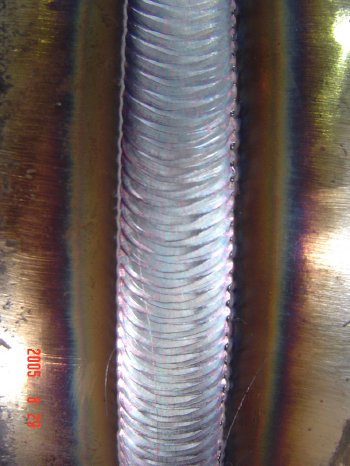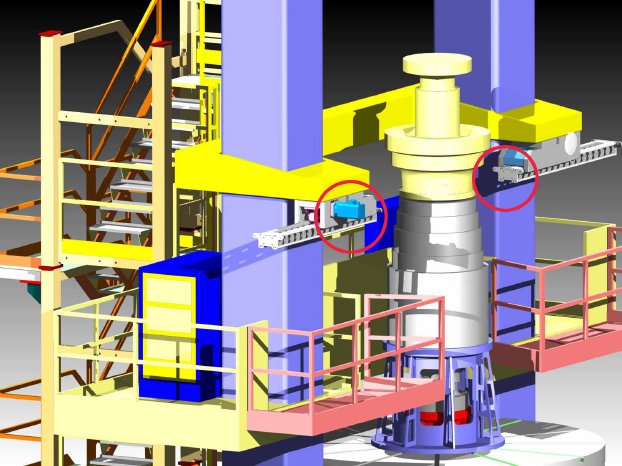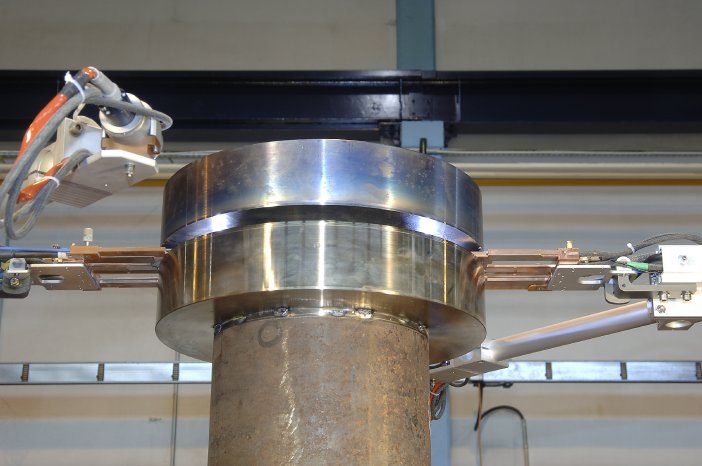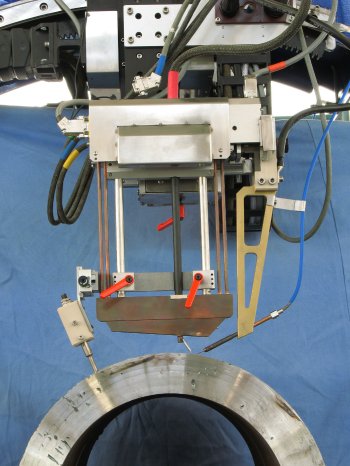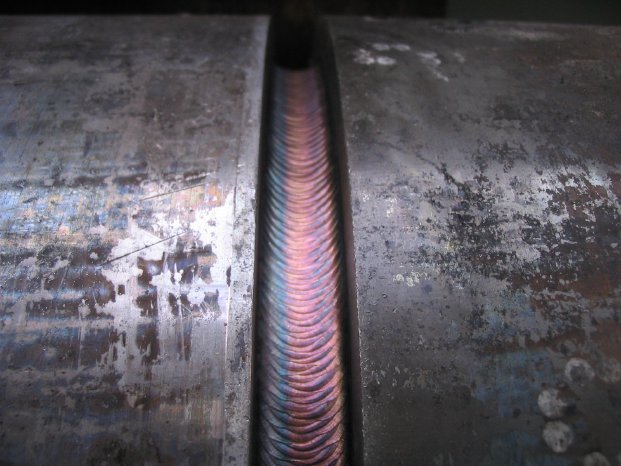This process has proven that once all the constraints have been taken into account; TIG narrow gap welding (fig. 1) remains the best process for dealing with the many inconsistencies that have to be incorporated to make automation successful.
The worldwide leader, POLYSOUDE (Nantes, France) has paid close attention to the various manufacturing conditions which, due to their complexity, require a specific solution almost every time. It brings accommodation of the technical procedure and the welding equipment to reach the most apposite compromise.
Economical Background
TIG welding of heavy wall thickness materials in an orbital configuration, or prefabricated on rotating work pieces is ever more common despite the many alternative technologies. This process has proven that once all the constraints have been taken into account; TIG welding remains the best process for dealing with the many inconsistencies that have to be incorporated to make automation successful.
Size of the workpiece
As a general rule, Narrow Gap welding will be cost-effective and technically efficient for thicknesses of more than 25 mm. For thicknesses of 60 mm and above, optimisation of welding time may achieve a factor of between 5 and 10 in relation to conventional TIG welding. This takes into account the combined effect of the reduction in the quantity of metal deposited and of the rate of deposition in the process.
Preparation and alignment conditions
The machining and alignment tolerances are used as the first significant criteria to confirm that a Narrow Gap TIG technique can be used. The lack of accessibility for manual welding due to the width of the weld groove only allows a small amount of flexibility and generally excludes situations wherein machine tools or alignment tooling cannot correct a poor alignment less than 75% of the thickness of the root face to be achieved with a gap which does not exceed 0.5 to 0.8 mm.
Grades and Operating Constraints
The grade(s) to be welded are essential when considering Narrow Gap welding. The ensuing weldability will determine the level of constraint to be considered for the equipment (thermal insulation, thermal screen, additional cooling system, specific saddles, etc.)
The mechanical characteristics of the materials and their behaviour in terms of welding shrinkage will be used to determine the profile of the weld groove (the angle of the weld groove will be chosen according to the grade and thickness to be welded) (fig 2).
Welding Position
The welding position is also fundamental in selecting the operating process. The need to weld in position will substantially reduce the level of productivity of the process which is characterised by different weld pass thicknesses. It should be noted that, depending on the materials and chemical analysis involved, there are applications where welding in and upward or downward direction cannot be performed.
The solution: use of two weld heads with symmetrical wire feeder for two weld directions.
Manufacturing Context
Some related factors could be influential when deciding on the operating process or simply disqualify the Narrow Gap approach; for instance : backing accessibility, control and traceability of supplies, management of base materials and filler wire products - important for reproducibility - means for carrying out the tests and to establish the parameter limits. The company should have a team of welding technicians and resources compatible with the required technical skills.
High Productivity
Narrow Gap TIG Welding, straight sinlge-pass by layer : This technique offers the best productivity gains while remaining simple for operators to carry out.
On the other hand, developing the welding process specification can be most tedious since every aspect must be taken into account, such as weld shrinkage and operating weldability.
The technique would be relatively simple since it consists of making a single-pass layer by layer and then including the weld shrinkage by adjusting the angle of the weld groove profile so that the width to be welded remains constant and between 8 and 10 mm (fig 3).
Thicknesses of less than 40 mm do not need a specific torch.
The adjustment of electrode stick-out is sufficient to ensure an effective level of gas protection for a majority of materials. It should be noted that POLYSOUDE has developed a motorised programmable device to make automation management easier, with fully automatic control of the length of the electrode, the diameter to be welded and the welding parameters without intervention by the operator. The most frequent use of this would be continuous rotating tube welding to avoid stopping between passes or orbital welding in harsh environments to control the electrode stick-out by remote control (fig. 4).
For the heaviest wall thicknesses engineering design involves, on the one hand, finding the best compromise to design sturdy torches but also compatible with the minimum width of weld grooves (i.e. a thickness of 7 mm for the torch body) and, in the other hand, to develop mechanical seam tracking to avoid collisions between torches and weld groove sides (fig. 5, 5a + 5b).
Alternative Technique
Narrow Gap TIG welding with dual-pass weld, layer by layer: This technique is an alternative to the single-pass weld by layer technique. It is used when the thickness is consistent and the financial or technical savings of the TIG process continue to be substantial despite welding times two or three times greater than the method used in the single-pass layer by layer process.
The key factors for selecting this alternative are primarily related to problems of preparation or alignment where the precision is incompatible with the single pass process or sensitive materials which need either limited constraints or limited welding heat input. In addition to that, dual-pass welding allows the use of larger heat-resistant torches with higher duty cycles (fig. 6 + 6a).
The interesting solution
Narrow Gap TIG welding, single-pass with oscillated electrode : This is an interesting variant for very heavy wall thicknesses, (of the order of 150 to 200 mm), where use of the technique in one pass per layer imposes technological constraints which may be at the limit of what is reasonable, (accuracy of the weld groove controlling shrinkage, proportion and technological limitation for design of the torch, etc.).
For this reason, and mainly for non-orbital applications, the oscillated passes technique can make it possible to combine the benefit of a single-pass weld layer by layer.
The equipment will be more complex, (motorised, controlled and programmable oscillation of the wire and the electrode), more bulky and usually, mounted on imposing installations (fig. 7 + 7a)
Single pass, dual pass, cold wire, hot wire ...
Based on the techniques and associated equipment described above, there are several variations possible (Fig. 8). There is always the choice between Hot wire TIG and cold wire TIG welding. Note: The selection of one of the variants often corresponds to intermediate situations which need compromises between the environment, human resources or the equipment available.
POLYSOUDE has become THE leading company in the field of TIG hot wire narrow gap welding. A large number of international companies, specialized in the construction of power plants (Alstom, Metso, Foster Wheeler, Shanghai Boiler, Harbin Boiler, Doosan, Siemens, Ansaldo) use this technology. The joining seams are 100% penetrated, x-ray proof and have the highest metallurgic and mechanical quality.
